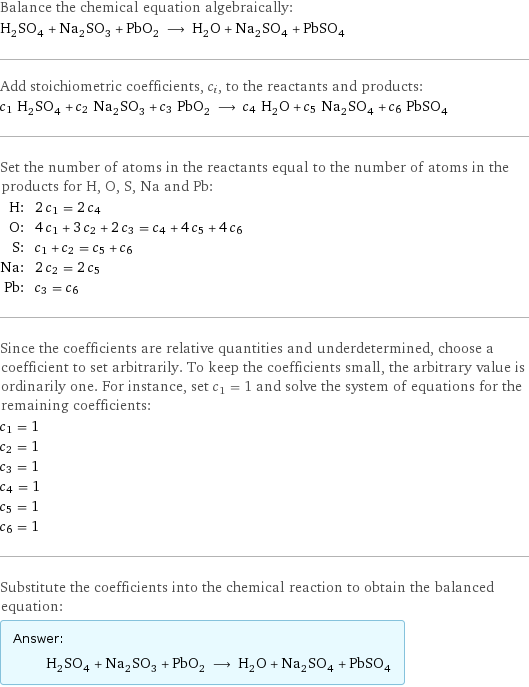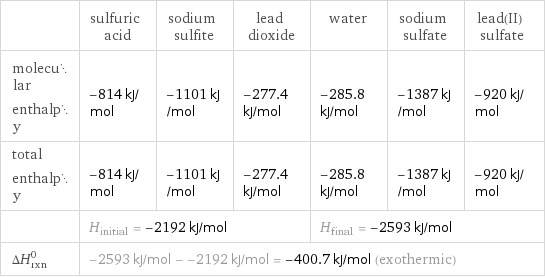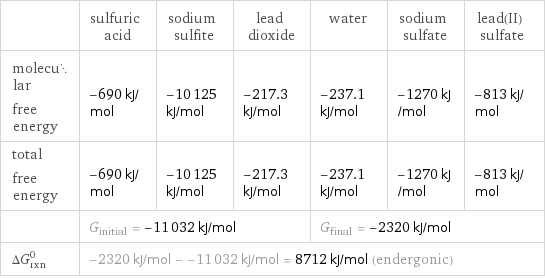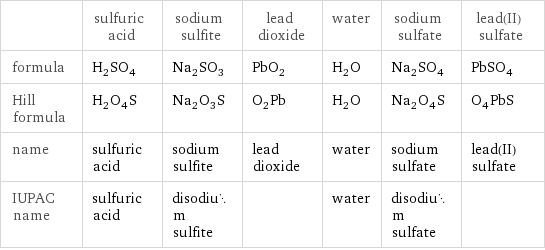Input interpretation

H_2SO_4 sulfuric acid + Na_2SO_3 sodium sulfite + PbO_2 lead dioxide ⟶ H_2O water + Na_2SO_4 sodium sulfate + PbSO_4 lead(II) sulfate
Balanced equation

Balance the chemical equation algebraically: H_2SO_4 + Na_2SO_3 + PbO_2 ⟶ H_2O + Na_2SO_4 + PbSO_4 Add stoichiometric coefficients, c_i, to the reactants and products: c_1 H_2SO_4 + c_2 Na_2SO_3 + c_3 PbO_2 ⟶ c_4 H_2O + c_5 Na_2SO_4 + c_6 PbSO_4 Set the number of atoms in the reactants equal to the number of atoms in the products for H, O, S, Na and Pb: H: | 2 c_1 = 2 c_4 O: | 4 c_1 + 3 c_2 + 2 c_3 = c_4 + 4 c_5 + 4 c_6 S: | c_1 + c_2 = c_5 + c_6 Na: | 2 c_2 = 2 c_5 Pb: | c_3 = c_6 Since the coefficients are relative quantities and underdetermined, choose a coefficient to set arbitrarily. To keep the coefficients small, the arbitrary value is ordinarily one. For instance, set c_1 = 1 and solve the system of equations for the remaining coefficients: c_1 = 1 c_2 = 1 c_3 = 1 c_4 = 1 c_5 = 1 c_6 = 1 Substitute the coefficients into the chemical reaction to obtain the balanced equation: Answer: | | H_2SO_4 + Na_2SO_3 + PbO_2 ⟶ H_2O + Na_2SO_4 + PbSO_4
Structures

+ + ⟶ + +
Names

sulfuric acid + sodium sulfite + lead dioxide ⟶ water + sodium sulfate + lead(II) sulfate
Reaction thermodynamics
Enthalpy

| sulfuric acid | sodium sulfite | lead dioxide | water | sodium sulfate | lead(II) sulfate molecular enthalpy | -814 kJ/mol | -1101 kJ/mol | -277.4 kJ/mol | -285.8 kJ/mol | -1387 kJ/mol | -920 kJ/mol total enthalpy | -814 kJ/mol | -1101 kJ/mol | -277.4 kJ/mol | -285.8 kJ/mol | -1387 kJ/mol | -920 kJ/mol | H_initial = -2192 kJ/mol | | | H_final = -2593 kJ/mol | | ΔH_rxn^0 | -2593 kJ/mol - -2192 kJ/mol = -400.7 kJ/mol (exothermic) | | | | |
Gibbs free energy

| sulfuric acid | sodium sulfite | lead dioxide | water | sodium sulfate | lead(II) sulfate molecular free energy | -690 kJ/mol | -10125 kJ/mol | -217.3 kJ/mol | -237.1 kJ/mol | -1270 kJ/mol | -813 kJ/mol total free energy | -690 kJ/mol | -10125 kJ/mol | -217.3 kJ/mol | -237.1 kJ/mol | -1270 kJ/mol | -813 kJ/mol | G_initial = -11032 kJ/mol | | | G_final = -2320 kJ/mol | | ΔG_rxn^0 | -2320 kJ/mol - -11032 kJ/mol = 8712 kJ/mol (endergonic) | | | | |
Equilibrium constant
![Construct the equilibrium constant, K, expression for: H_2SO_4 + Na_2SO_3 + PbO_2 ⟶ H_2O + Na_2SO_4 + PbSO_4 Plan: • Balance the chemical equation. • Determine the stoichiometric numbers. • Assemble the activity expression for each chemical species. • Use the activity expressions to build the equilibrium constant expression. Write the balanced chemical equation: H_2SO_4 + Na_2SO_3 + PbO_2 ⟶ H_2O + Na_2SO_4 + PbSO_4 Assign stoichiometric numbers, ν_i, using the stoichiometric coefficients, c_i, from the balanced chemical equation in the following manner: ν_i = -c_i for reactants and ν_i = c_i for products: chemical species | c_i | ν_i H_2SO_4 | 1 | -1 Na_2SO_3 | 1 | -1 PbO_2 | 1 | -1 H_2O | 1 | 1 Na_2SO_4 | 1 | 1 PbSO_4 | 1 | 1 Assemble the activity expressions accounting for the state of matter and ν_i: chemical species | c_i | ν_i | activity expression H_2SO_4 | 1 | -1 | ([H2SO4])^(-1) Na_2SO_3 | 1 | -1 | ([Na2SO3])^(-1) PbO_2 | 1 | -1 | ([PbO2])^(-1) H_2O | 1 | 1 | [H2O] Na_2SO_4 | 1 | 1 | [Na2SO4] PbSO_4 | 1 | 1 | [PbSO4] The equilibrium constant symbol in the concentration basis is: K_c Mulitply the activity expressions to arrive at the K_c expression: Answer: | | K_c = ([H2SO4])^(-1) ([Na2SO3])^(-1) ([PbO2])^(-1) [H2O] [Na2SO4] [PbSO4] = ([H2O] [Na2SO4] [PbSO4])/([H2SO4] [Na2SO3] [PbO2])](../image_source/3fb06d76b5f3d33f86da6d981225bc1a.png)
Construct the equilibrium constant, K, expression for: H_2SO_4 + Na_2SO_3 + PbO_2 ⟶ H_2O + Na_2SO_4 + PbSO_4 Plan: • Balance the chemical equation. • Determine the stoichiometric numbers. • Assemble the activity expression for each chemical species. • Use the activity expressions to build the equilibrium constant expression. Write the balanced chemical equation: H_2SO_4 + Na_2SO_3 + PbO_2 ⟶ H_2O + Na_2SO_4 + PbSO_4 Assign stoichiometric numbers, ν_i, using the stoichiometric coefficients, c_i, from the balanced chemical equation in the following manner: ν_i = -c_i for reactants and ν_i = c_i for products: chemical species | c_i | ν_i H_2SO_4 | 1 | -1 Na_2SO_3 | 1 | -1 PbO_2 | 1 | -1 H_2O | 1 | 1 Na_2SO_4 | 1 | 1 PbSO_4 | 1 | 1 Assemble the activity expressions accounting for the state of matter and ν_i: chemical species | c_i | ν_i | activity expression H_2SO_4 | 1 | -1 | ([H2SO4])^(-1) Na_2SO_3 | 1 | -1 | ([Na2SO3])^(-1) PbO_2 | 1 | -1 | ([PbO2])^(-1) H_2O | 1 | 1 | [H2O] Na_2SO_4 | 1 | 1 | [Na2SO4] PbSO_4 | 1 | 1 | [PbSO4] The equilibrium constant symbol in the concentration basis is: K_c Mulitply the activity expressions to arrive at the K_c expression: Answer: | | K_c = ([H2SO4])^(-1) ([Na2SO3])^(-1) ([PbO2])^(-1) [H2O] [Na2SO4] [PbSO4] = ([H2O] [Na2SO4] [PbSO4])/([H2SO4] [Na2SO3] [PbO2])
Rate of reaction
![Construct the rate of reaction expression for: H_2SO_4 + Na_2SO_3 + PbO_2 ⟶ H_2O + Na_2SO_4 + PbSO_4 Plan: • Balance the chemical equation. • Determine the stoichiometric numbers. • Assemble the rate term for each chemical species. • Write the rate of reaction expression. Write the balanced chemical equation: H_2SO_4 + Na_2SO_3 + PbO_2 ⟶ H_2O + Na_2SO_4 + PbSO_4 Assign stoichiometric numbers, ν_i, using the stoichiometric coefficients, c_i, from the balanced chemical equation in the following manner: ν_i = -c_i for reactants and ν_i = c_i for products: chemical species | c_i | ν_i H_2SO_4 | 1 | -1 Na_2SO_3 | 1 | -1 PbO_2 | 1 | -1 H_2O | 1 | 1 Na_2SO_4 | 1 | 1 PbSO_4 | 1 | 1 The rate term for each chemical species, B_i, is 1/ν_i(Δ[B_i])/(Δt) where [B_i] is the amount concentration and t is time: chemical species | c_i | ν_i | rate term H_2SO_4 | 1 | -1 | -(Δ[H2SO4])/(Δt) Na_2SO_3 | 1 | -1 | -(Δ[Na2SO3])/(Δt) PbO_2 | 1 | -1 | -(Δ[PbO2])/(Δt) H_2O | 1 | 1 | (Δ[H2O])/(Δt) Na_2SO_4 | 1 | 1 | (Δ[Na2SO4])/(Δt) PbSO_4 | 1 | 1 | (Δ[PbSO4])/(Δt) (for infinitesimal rate of change, replace Δ with d) Set the rate terms equal to each other to arrive at the rate expression: Answer: | | rate = -(Δ[H2SO4])/(Δt) = -(Δ[Na2SO3])/(Δt) = -(Δ[PbO2])/(Δt) = (Δ[H2O])/(Δt) = (Δ[Na2SO4])/(Δt) = (Δ[PbSO4])/(Δt) (assuming constant volume and no accumulation of intermediates or side products)](../image_source/b5512bcdb34f3c54e84a3f878085b773.png)
Construct the rate of reaction expression for: H_2SO_4 + Na_2SO_3 + PbO_2 ⟶ H_2O + Na_2SO_4 + PbSO_4 Plan: • Balance the chemical equation. • Determine the stoichiometric numbers. • Assemble the rate term for each chemical species. • Write the rate of reaction expression. Write the balanced chemical equation: H_2SO_4 + Na_2SO_3 + PbO_2 ⟶ H_2O + Na_2SO_4 + PbSO_4 Assign stoichiometric numbers, ν_i, using the stoichiometric coefficients, c_i, from the balanced chemical equation in the following manner: ν_i = -c_i for reactants and ν_i = c_i for products: chemical species | c_i | ν_i H_2SO_4 | 1 | -1 Na_2SO_3 | 1 | -1 PbO_2 | 1 | -1 H_2O | 1 | 1 Na_2SO_4 | 1 | 1 PbSO_4 | 1 | 1 The rate term for each chemical species, B_i, is 1/ν_i(Δ[B_i])/(Δt) where [B_i] is the amount concentration and t is time: chemical species | c_i | ν_i | rate term H_2SO_4 | 1 | -1 | -(Δ[H2SO4])/(Δt) Na_2SO_3 | 1 | -1 | -(Δ[Na2SO3])/(Δt) PbO_2 | 1 | -1 | -(Δ[PbO2])/(Δt) H_2O | 1 | 1 | (Δ[H2O])/(Δt) Na_2SO_4 | 1 | 1 | (Δ[Na2SO4])/(Δt) PbSO_4 | 1 | 1 | (Δ[PbSO4])/(Δt) (for infinitesimal rate of change, replace Δ with d) Set the rate terms equal to each other to arrive at the rate expression: Answer: | | rate = -(Δ[H2SO4])/(Δt) = -(Δ[Na2SO3])/(Δt) = -(Δ[PbO2])/(Δt) = (Δ[H2O])/(Δt) = (Δ[Na2SO4])/(Δt) = (Δ[PbSO4])/(Δt) (assuming constant volume and no accumulation of intermediates or side products)
Chemical names and formulas

| sulfuric acid | sodium sulfite | lead dioxide | water | sodium sulfate | lead(II) sulfate formula | H_2SO_4 | Na_2SO_3 | PbO_2 | H_2O | Na_2SO_4 | PbSO_4 Hill formula | H_2O_4S | Na_2O_3S | O_2Pb | H_2O | Na_2O_4S | O_4PbS name | sulfuric acid | sodium sulfite | lead dioxide | water | sodium sulfate | lead(II) sulfate IUPAC name | sulfuric acid | disodium sulfite | | water | disodium sulfate |
Substance properties

| sulfuric acid | sodium sulfite | lead dioxide | water | sodium sulfate | lead(II) sulfate molar mass | 98.07 g/mol | 126.04 g/mol | 239.2 g/mol | 18.015 g/mol | 142.04 g/mol | 303.3 g/mol phase | liquid (at STP) | solid (at STP) | solid (at STP) | liquid (at STP) | solid (at STP) | solid (at STP) melting point | 10.371 °C | 500 °C | 290 °C | 0 °C | 884 °C | 1087 °C boiling point | 279.6 °C | | | 99.9839 °C | 1429 °C | density | 1.8305 g/cm^3 | 2.63 g/cm^3 | 9.58 g/cm^3 | 1 g/cm^3 | 2.68 g/cm^3 | 6.29 g/cm^3 solubility in water | very soluble | | insoluble | | soluble | slightly soluble surface tension | 0.0735 N/m | | | 0.0728 N/m | | dynamic viscosity | 0.021 Pa s (at 25 °C) | | | 8.9×10^-4 Pa s (at 25 °C) | | odor | odorless | | | odorless | |
Units
